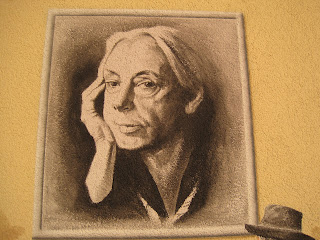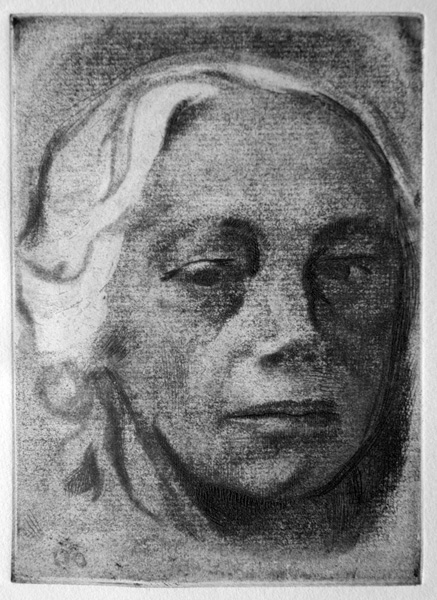We are at the 66th anniversary of the destruction of Dresden in the last year of World War II. The anniversary is obviously a major event here every year. The destruction was far and away more devastating than Dresden's military importance warranted (though the importance was apparently not negligible). The Americans and British sent bombers to destroy the city and help break the spirit of the German people. Kurt Vonnegut witnessed it from the relative safety of a slaughterhouse a mile or so from downtown, where he was a POW. From my vantage point 66 years later, I do have some observations.

The above photo is the iconic one of the destroyed city. Photographer Richard Peter climbed the tower on the Rathaus, which miraculously was spared destruction, and stood behind the statue on top for this shot. The destruction of the city center was, as you can see, total. Pictures taken a couple years later, after the rubble had been removed, show wide open fields in what was once dense city, sometimes with flocks of sheep grazing and shepherds tending. I have spent rather little time searching the internet for this, but I'm sure there exists a map showing the extent of the destruction. I do know that it extended into and well beyond my neighborhood of Johannstadt. By the way, a few years ago, the Rathaus tower was renovated, and a gilded statue placed on top:
The other day, Lisa and I went on the Kurt Vonnegut tour of Dresden, primarily at the big former slaughterhouses north of downtown near the Elbe. It's run by a small tour organization, and can be booked for a reasonable price here:
http://www.kurtvonnegut-tour.com/

Our guide, Danilo, was remarkably informative, with lots of information on the history of the destruction, the numbers of the dead (and the controversies surrounding the number), and of course, Vonnegut's place in it. The giant slaughterhouse complex was built around 1910, and was "decommissioned" some years ago. It is now the fairgrounds for trade fairs in Dresden, and is still in flux -- partly still evolving into fairgrounds and a hotel, partly (and slowly) being renovated for historical interest, and partly being used for a large annual modern art exhibition called the Ostrale. Danilo's group has gotten them to open the one cellar still in existence to show visitors on his tours. He has convinced them to put up a plaque that says "Slaughterhouse 5," and hopes eventually to get a small Vonnegut museum placed there. The cellars were used as cool storage for animal carcasses prior to processing, and it is where the POWs were housed. It cannot be said with certainty that the one that is open is exactly where Vonnegut stayed, but it is close enough.

In general, the slaughterhouse complex now looks eerily like a former concentration camp (or not so eerily, if you're from PETA). The giant indoor stockyards seem to have guard towers, and there are scary looking smokestacks and creepy buildings you can't go into. We'll see what it looks like in another decade or so. The renovations here lag way behind other re-building being done in the inner city since reunification.
 |
| Pillnitzer Str. |
 |
| St. Petersburg Str. |
Which brings me to another subject: the massive bombing 66 years ago certainly wiped out the city, but in four decades, the communist dictatorship was unable to rebuild very much. They built housing and basic infrastructure, but didn't have the "Kapital" to rebuild much of the historic stuff. The Semper Opera House, they did. The Frauenkirche (Church of Our Lady) had to wait until the capitalists took over. So this latter basic completion to the famous Dresden skyline had to wait until 2004 (though I do agree with the communists' priorities). But what you see now is a very odd city. The central old city has been about 3/4 rebuilt with restored or reconstructed buildings that match or imitate in modern style what used to be there, and mostly since reunification. But beyond downtown is a very different landscape. Often you see one 5-6 story apartment building after another, with oddly wide streets and enormous open spaces almost like giant front yards, often planted with fairly young trees. The picture above is just outside of downtown. I can only imagine the city was once more densely built than that. Downtown, the old St. Petersburg St. is relatively bare. In contrast, West German cities were more uniformly and organically rebuilt. Overall a better plan.
I remember from listening to East German radio in the early 80s that they never missed an opportunity to note the destruction of Dresden "by Anglo-American bombers." They never mentioned, of course, that the East Germans' great friend, the Soviet Union, did indeed push for the bombing of Dresden during the war. Is all history revisionist?
I am writing this on Saturday the 12th. Tomorrow, the anniversary of the bombings, will have big demonstrations downtown. The neo-nazis are descending from all over to memorialize the huge numbers of innocent Germans killed in the war. They were victims, too. The neo-nazis plan a big march. But at least as far as the publicity that I am aware of indicates, their march will be dwarfed by a human chain demonstration surrounding the inner city:
http://13februar.dresden.de/de/menschenkette.php
I plan to be a part of it. It is being called for by a huge coalition, starting with Mayor Helma Orosz. Unfortunately, last Monday she had surgery to remove a breast tumor, so she will be represented by the Vice Mayor. The University is a big organizer of the event, and religious and union groups are also involved (including the Jewish community). There is a big controversy, as well as plenty of uncertainty, as to the legalities in such protests, and what the police will be doing. Last year, apparently, the police did not protect the neo-nazi demonstration from counter-demonstrators. I don't know exactly what happened, but it lead to a court case where it was just ruled that the neo-nazis had the right to demonstrate peacefully, and the police should have protected them. I am hearing that this year, the police will protect the neo-nazi demonstration, to the displeasure of most, and probably to the anger of the far left protesters. I expect to be far from any clashes that might occur, though I predict little real problem. Germany has laws against certain Nazi symbols and rhetoric, though political parties can be about as far right as they want.
One of the long-standing controversies is over the number of civilians killed here 66 years ago. An official commission recently thoroughly investigated the matter and decided that the true figure lies between 25,000 and 32,000 people. The neo-nazis of course use an inflated figure, in spite of the commission's finding. And figures up to 300,000 have been used practically from the start. What can one say? Is 30,000 people burnt alive better than 300,000? Of course. Did the Germans have it coming? I learned that the Geneva Conventions didn't get around to "banning" targeting of civilians like that until the 1970s. The answer for some people is that the event was a horrible thing, not justified, but also not entirely wrong. It was a terrible time in our history.




















 It's been a long time since I've written, and of course the big thing that has happened in the meantime is my trip to play two concerti in Phoenix. Or more accurately, at Arizona State in Tempe. The concert went well and was well received and all that, but the main thing is that I got to Carolina's again after 18 years. Worth the trip, and the wait.
It's been a long time since I've written, and of course the big thing that has happened in the meantime is my trip to play two concerti in Phoenix. Or more accurately, at Arizona State in Tempe. The concert went well and was well received and all that, but the main thing is that I got to Carolina's again after 18 years. Worth the trip, and the wait. Saw a wonderful sign within the castle area, just across from the side of the castle cathedral: "Historical Prison, with building permits, for lease or sale." I want to put in an offer, and when they ask what I plan to do with it, say "Keep prisoners there, of course."
Saw a wonderful sign within the castle area, just across from the side of the castle cathedral: "Historical Prison, with building permits, for lease or sale." I want to put in an offer, and when they ask what I plan to do with it, say "Keep prisoners there, of course."










 Remember Fidelio F. Finke Street? (See 20 December 2010.) Well...through my connections, I was led into the music department offices of the big library -- closest I've come to the actual manuscripts I'm working on. And there hanging in the hallway was a set of pastels of scenic designs for Finke's 1960 opera, Der Zauberfisch, or The Magic Fish. Whipped out my camera and took a couple shots. (This is the good one.) Finke was a favorite composer of the communist East German regime. Born elsewhere, he lived, worked, and died in Dresden.
Remember Fidelio F. Finke Street? (See 20 December 2010.) Well...through my connections, I was led into the music department offices of the big library -- closest I've come to the actual manuscripts I'm working on. And there hanging in the hallway was a set of pastels of scenic designs for Finke's 1960 opera, Der Zauberfisch, or The Magic Fish. Whipped out my camera and took a couple shots. (This is the good one.) Finke was a favorite composer of the communist East German regime. Born elsewhere, he lived, worked, and died in Dresden.


 Our guide, Danilo, was remarkably informative, with lots of information on the history of the destruction, the numbers of the dead (and the controversies surrounding the number), and of course, Vonnegut's place in it. The giant slaughterhouse complex was built around 1910, and was "decommissioned" some years ago. It is now the fairgrounds for trade fairs in Dresden, and is still in flux -- partly still evolving into fairgrounds and a hotel, partly (and slowly) being renovated for historical interest, and partly being used for a large annual modern art exhibition called the Ostrale. Danilo's group has gotten them to open the one cellar still in existence to show visitors on his tours. He has convinced them to put up a plaque that says "Slaughterhouse 5," and hopes eventually to get a small Vonnegut museum placed there. The cellars were used as cool storage for animal carcasses prior to processing, and it is where the POWs were housed. It cannot be said with certainty that the one that is open is exactly where Vonnegut stayed, but it is close enough.
Our guide, Danilo, was remarkably informative, with lots of information on the history of the destruction, the numbers of the dead (and the controversies surrounding the number), and of course, Vonnegut's place in it. The giant slaughterhouse complex was built around 1910, and was "decommissioned" some years ago. It is now the fairgrounds for trade fairs in Dresden, and is still in flux -- partly still evolving into fairgrounds and a hotel, partly (and slowly) being renovated for historical interest, and partly being used for a large annual modern art exhibition called the Ostrale. Danilo's group has gotten them to open the one cellar still in existence to show visitors on his tours. He has convinced them to put up a plaque that says "Slaughterhouse 5," and hopes eventually to get a small Vonnegut museum placed there. The cellars were used as cool storage for animal carcasses prior to processing, and it is where the POWs were housed. It cannot be said with certainty that the one that is open is exactly where Vonnegut stayed, but it is close enough. 

